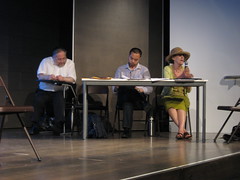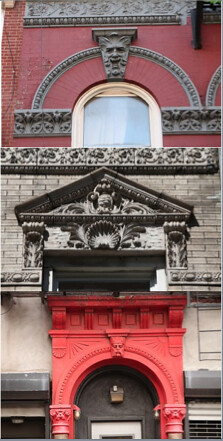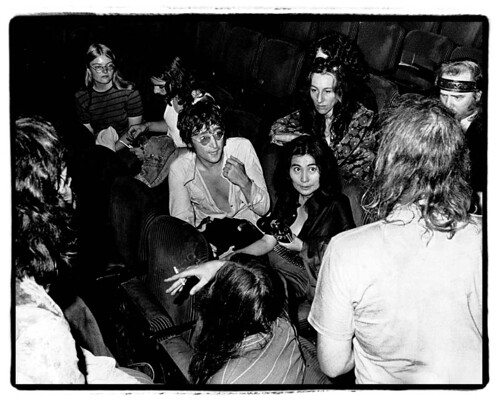Tomorrow, a public hearing by the Landmarks Preservation Commission will determine the future of East 10th Street along Tompkins Square Park. Over the weekend, The Local spoke with Andrew Berman, the executive director of the Greenwich Village Society for Historic Preservation, about the history of the strip.
293 East 10th Street
 G.V.S.H.P. 293 East 10th Street
G.V.S.H.P. 293 East 10th StreetThis building, like a lot of buildings in the East Village, shows in a very material way the evolution of the neighborhood from a place of single-family homes for the merchant class to the locus of immigration to New York City. It was built at the corner of East 10th and Avenue A in 1845 for James French, a boot-maker.
Only five years later it was sold to a gentleman named Joshua Varian and a Haraim Chandler leased it from him. Chandler lived with seven other families. This building very quickly became a multi-family home, or a tenement. By the late 1890s it was owned by Charles J. Smith, whose name still appears on the top left-hand side of the building. The top floor of the building was probably added by Smith as part of the tenementi-zation of it.
Interestingly, we know that Chandler worked for the N.Y.P.D. very early in its existence; it was only founded in 1845. Chandler worked as a detective and was injured during the 1863 draft riots. He died in 1881.
Read more…
 David Jarrett Details from a building within one of the two proposed districts.
David Jarrett Details from a building within one of the two proposed districts.A critical hearing regarding a proposed landmark district on East 10th Street has been expedited due to a controversial application for an addition to a building in the area, the Landmarks Preservation Commission revealed today.
Last week, the real estate magnate Ben Shaoul applied for an additional floor to 315 East 10th Street along Tompkins Square Park, which he had recently purchased. The rooftop addition, which would be a departure from the 26 buildings – most of which are four-story 19th- and 20th-century dwellings – that line the block, garnered the attention of the city Landmarks Preservation Commission.
“The reason we’re scheduling the date earlier than we planned is that the Department of Buildings notified the Commission’s staff this past Sunday that the owner of 315 East 10th Street had filed an application for a permit to construct a rooftop addition that could potentially affect the character of the proposed district,” wrote Elisabeth de Bourbon, a spokeswoman for the Commission. Read more…
Community Board 3 tonight approved the creation of two historic districts in the East Village, paving the way for official consideration by the city. The proposal was divided into two separate motions with a 23 to 9 vote in favor of the Second Avenue district and unanimous support for the Tenth Street district. Preservationists reiterated that the measures were the only way to protect the neighborhood from what they consider excessive development while opponents from the religious community, some of whom walked out of the meeting in protest, countered that they could not bear the financial burden of renovations under the landmarking requirements.
—Laura E. Lee and Stephen Rex Brown
 Stephen Rex Brown The subcommittee at tonight’s meeting.
Stephen Rex Brown The subcommittee at tonight’s meeting.The divide between preservationists and the opponents of a proposed historic district in the neighborhood was on full display Thursday night, as critics of the plan derided a proposed landmark district as an insult to some area institutions.
Supporters of the planned district, covering 330 buildings near Second Avenue and one block of Tompkins Square Park, countered that it would protect the East Village from development and preserve the architectural features of the neighborhood for future generations.
Opponents of the plan, led by representatives from three houses of worship — Congregation Meseritz Syngg, the Orthodox Cathedral of the Holy Virgin Protection and St. Stanislaus Church — questioned whether the district would place an undue burden on them by requiring that they pay for the increased maintenance and upkeep of their buildings.
By the end of the two-hour meeting of Community Board 3’s landmarks subcommittee at 41 Cooper Square it was clear that the debate is far from over.
Read more…
 David Jarrett The leaders of two local houses of worship have emerged as critics of the proposed historic district in the East Village.
David Jarrett The leaders of two local houses of worship have emerged as critics of the proposed historic district in the East Village.Thus far, the proposed East Village historic district has been met with relatively little opposition — but that looks as if it is going to change.
The leaders of two local houses of worship have emerged as outspoken opponents of the proposed district in the neighborhood, which they say would lead to unnecessary expense and bureaucratic inconveniences.
Rabbi Pesach Ackerman of the Congregation Meseritz Syngg on Sixth Street and Father Christopher Calin of the Orthodox Cathedral of the Holy Virgin Protection both bristled at the notion that they would have to get approval from the city Landmarks Preservation Commission before renovating the exteriors of their religious institutions.
“Once you’re landmarked, you’re not the owners of the building anymore,” said Mr. Ackerman, who has been the Rabbi of Meseritz Syngg for 42 years. “Anything you do, you have to ask their permission.”
Representatives from both institutions, along with those in favor of the district, are expected to speak on Thursday during a meeting of Community Board 3, which will be dedicated to the proposal.
Read more…
Earlier today, we wrote about the Fillmore East, one of the more remarkable properties within the confines of a proposed landmark district. The unofficial house photographer of the Fillmore East, Amalie R. Rothschild, shared her photos and memories from the theater’s brief yet influential existence from 1968 to 1971. — Stephen Rex Brown
Read more…








